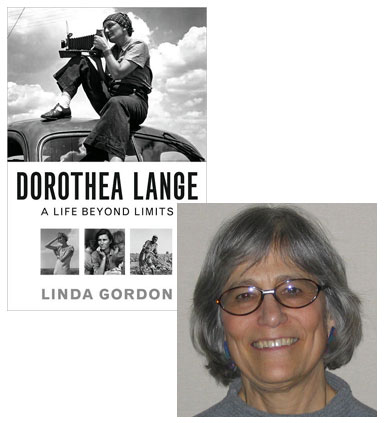Linda Gordon’s Sideways Entry into Dorothea Lange’s Biography

If you read this weekend’s NY Times Book Review, you might have seen where Dorothea Lange: A Life Beyond Limits was hailed as “an absorbing, exhaustively researched and highly political biography of a transformative figure in the rise of modern photojournalism.” The book had first crossed my desk a few weeks ago, and when it arrived I had been curious about what had attracted NYU history professor Linda Gordon to Lange as a subject. The answer, which I’m able to share with you now, was surprising—and proof (if any were needed) that a writer should always strive to keep herself open to possibility.
If I were a religious person I might conclude that I was commanded by some greater power to write about Dorothea Lange. One day, around 2001, I got a phone call from a friend in California asking if I’d like to write Lange’s biography. It seemed that a biographer, Henry Mayer, had been planning to write about Lange but died suddenly of a heart attack; friends of his had thought the materials he had collected should be passed on to someone who could use them—and they thought of me.
At first I said no, I’m not a biographer and I don’t know photography. I thought maybe I could help find the right person to take up the project, though, so I began to read a bit about Lange. Soon, coincidences piled up. I had been planning in my next project to write about the New Deal, Franklin Delano Roosevelt’s heroic response to the great depression of the 1930s, and it was the New Deal that gave birth to Lange as a documentary photographer. I had been planning to write about the west—I’m from Portland, Oregon—and discovered that Lange was a westerner and that much of her photography covered the western states, including my own. Another striking piece of serendipity: Her second husband was a scholar whose work I had pored over for my previous book (The Great Arizona Orphan Abduction), never dreaming that he was married to a major artist.
It was a deeper discovery, emotional and intellectual and political, that finally pushed me into the biography, however. Documentary photographers, I think, resemble historians, or at least historians like me. Documentary grows out of artists’ sense of social responsibility rather than the withdrawal from the world that some artists practice. The documentary mode does not usually pretend to ethical neutrality; the motive behind documentary has been to bring social problems to public attention. This fact produces a creative tension, because documentary and history both require absolute fidelity to the facts even as they are both interpretive disciplines.
But I like such tension, just as I like complexity. And Dorothea Lange was as far as possible from simple. She was by no means the saintly, self-effacing personality that many had assumed her to be, extrapolating from her photography. On the contrary: She was passionate and charismatic, driven by ambition, sometimes irritable, often demanding—yet uncommonly sensitive and generous. In short, a personality of intensity and complexity and, therefore, a particularly fascinating subject.
25 October 2009 | guest authors |

 Our Endless and Proper Work is my new book with Belt Publishing about starting (and sticking to) a productive writing practice.
Our Endless and Proper Work is my new book with Belt Publishing about starting (and sticking to) a productive writing practice. 
